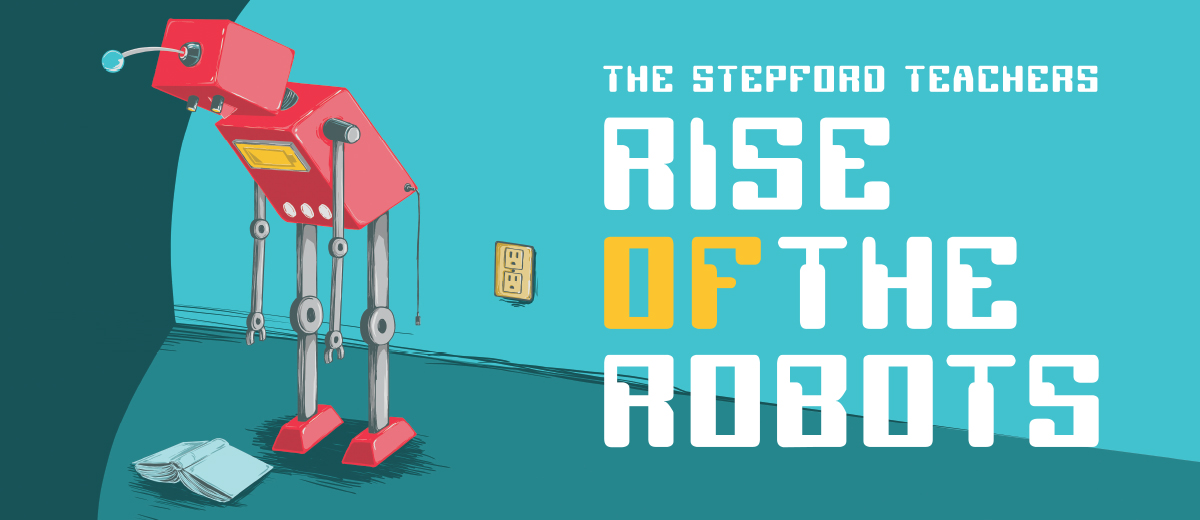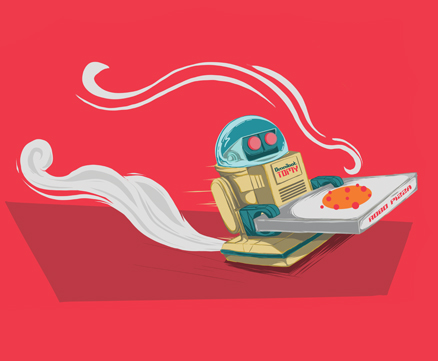
Story By George Stephenson, Illustrations By Matt Kehler
Over the past five years students in some parts of the world have been greeted in their classrooms by teachers who appear to have come off the set of a George Lucas movie.
Robots have been teaching classes in Japan, South Korea and Abu Dhabi.
Throughout the world humans in various jobs are being replaced by robots at an ever-accelerating pace. The question for many people is whether their work will disappear with the rise of the machines.
Most think not.
Pollsters have found that while a vast majority of people think robots will take over many jobs, a vast majority also believe that their jobs will not be among them.
That would hold true for teaching where few educators believe that a robot, no matter how sophisticated or artificially intelligent, could replace a teacher.
South Korea, though, literally rolled out robots the size of young teens in 21 classrooms back in 2011 to teach English, a specialty for which it was having trouble recruiting human teachers.
A private school in Abu Dhabi announced in 2014 it was buying 30 robots to replace humans to teach basic math and special needs students.
“I have sourced out some of the best and most advanced robots including humanoids, quadrupeds, hexapods, flying robots and pet robots from all over the world,” said the school’s founder. “Our aim is to mould future scientists, designers, engineers and leaders.”
Certainly a lofty goal for a battery-based learning system.
Whether that goal turns out to be fact or fantasy, the robot revolution is making inroads into numerous workplaces.
Last January a study by McKinsey & Company, a worldwide management consulting firm, concluded 30 per cent of tasks performed by 60 per cent of occupations could be done by computers and their more mobile form, robots.
A Merrill Lynch study predicted that 47 per cent of all jobs are at risk of replacement in the next 20 years. It mainly cited jobs in manufacturing and service industries.
In Canada, a report by the Brookfield Institute for Innovation and Entrepreneurship at Toronto’s Ryerson University, said 42 per cent of Canadian jobs are at high risk of being replaced by technology.
More jobs are at risk than others. Everyone knows that some telemarketing functions are now done by computers and others, at most risk, are those that are routine and repetitive. Teaching would not fall into that category.
The Merrill Lynch report concluded that robots would not be able to replicate jobs that involve creative thinking.
“As machines begin to eliminate the most menial tasks, people are left with more time to deploy creative abilities, blurring the line between mind and machine,” it says. “A major question is whether this will empower humans to go further than before or if people will just be pushed out.”
Business Insider magazine quotes Ian Pearson, a fellow at the World Academy for Arts and Sciences, as believing certain human skills will protect some jobs from the robot overlords.
Teachers are among those few positions.
“You can’t really say, ‘because you have Google you don’t need a teacher anymore because you can find everything you want on Google’ – that teacher could be replaced notionally by a robot, but the robot couldn’t really quite understand where the kid is coming from because they don’t share the same human experience,” Pearson says.
Still, computer scientists in labs across the globe are working to perfect robots that can interact with humans and teach at least basic skills.

South Korea literally rolled out robots the size of young teens in 21 classrooms back in 2011 to teach English, a specialty for which it was having trouble recruiting human teachers. A private school in Abu Dhabi announced in 2014 it was buying 30 robots to replace humans to teach basic math and special needs students.
They have so far developed complex artificial intelligence software that allows robots to track motion and recognize speech.
Brian David Johnston, author of 21st Century Robot, gave his assessment to IQ.intel.com of the potential of robots to replace teachers: “No. Never. Ever. Ever.”
“Inherently, education is about people, but robots can be excellent extensions of parents and teachers at home and in the classroom.”
He says robots can help human teachers in a number of ways. For example giving certain students more attention than the human is capable. And they can be better than other classroom technologies.
“Unlike computers or tablets, robots are social and can connect with children.”
He says robots can function the same way other devices have been used in schools.
“All technology is a tool – just different types of hammers. Technology frees humans up to do what they are really good at.”
Back in South Korea, even though there are robots in some classrooms, there are still human teachers behind the scenes.
The robots are connected through teleconferencing with human instructors, who are also needed to develop lessons that are pre-loaded into the robots.
At the moment most predictions suggest that robots will take on certain tasks of most jobs and that the roles of workers will be redefined.
Indeed, in a report on the rise of robotics, the Guardian newspaper points out that in the past 60 years only one occupation has actually been eliminated by automation: elevator operator.
“In the past, reports of the death of human jobs have often been greatly exaggerated, and technology has created more jobs than it has wiped out,” it said. “It’s called the Luddite Fallacy, in reference to the 19th Century group of textile workers who smashed the new weaving machinery that made their skills redundant.”
It doesn’t mean, however, that many occupations will not face upheaval by the introduction of robots in the workplace both outside and within schools.
Gavin Newsome, former mayor of San Francisco and California lieutenant governor, has put the rise of robotics in one of the major planks in his campaign for governor.
“This is code red, a firehouse, a tsunami that’s coming our way,” he told The Guardian. “We’re going to get rolled over unless we get ahead of this.”
Newsome has seen the wave first hand with San Francisco being ground zero in the rise of the machines. Delivery robots can be seen tested on city sidewalks and there are coffee shops that have no human servers or cashiers. It is the test tube for tech and no idea seems too outlandish. Just 10 years ago the idea of driverless cars was considered beyond the scope of androids and algorithms.
In teaching, as with other occupations, the financial aspects will play a role as some governments try to replace workers with full robots or computer software, with private suppliers seeing a profit in the idea. McGraw-Hill has already designed software to allow college professors to manage coursework for hundreds of students at a time.
The idea of replacing teachers with robots no doubt brings a glint in the eye of some of the more conservative governments, but the savings may not be all that solid. Some politicians and tech entrepreneurs are already calling for robots to be assessed the same income taxes as the humans they replace.
Bill Gates, co-founder of Microsoft, said in an interview with Quartz that there should be a robot tax.
“Right now if a human worker does $50,000 worth of work in a factory that income is taxed. If a robot comes in to do the same thing, you’d think we’d tax the robot at a similar level.”
Then there is the cost of maintenance of robots, which one can assume will have more glitches than an overhead projector. And what happens when it runs out of power in the middle of the day and nobody can find the right cord to recharge it?
Educators might be pining for those days when the biggest technological challenge was getting their PowerPoint to work.
— This story was originally printed in the October-November 2017 issue of The Manitoba Teacher Magazine
